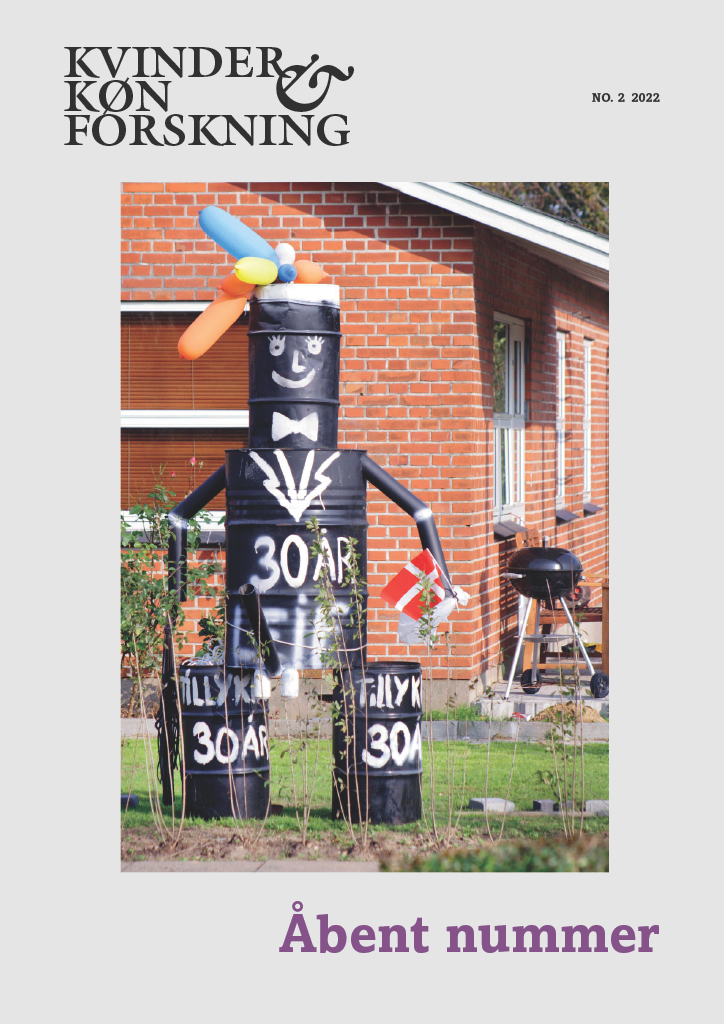Woman, Life, Freedom
On protests in Iran and Why it is a feminist movement
DOI:
https://doi.org/10.7146/kkf.v34i1.134480Nøgleord:
Mandatory hijab, Iran's protests, politics of hair, gender, activismResumé
In this essay, I draw on the lyrics of a viral song by Shervin Hajipour titled “Baraye” (meaning: for the sake of) that was released on 28 September 2022 and immediately became the anthem of the protests in Iran. I quote excerpts of the lyrics in three sections of this essay, connecting them to the slogan “Woman, Life, Freedom” chanted in the streets and the symbolic act of cutting one’s hair that has come to represent the protests. In the first of these sections, on woman, I reflect on the regime’s gender politics (of hair), arguing that the act of cutting one’s hair becomes a symbolic act of resisting such gender politics. In the second section, on life, I focus on the act of cutting hair as a mode of mourning the unjust and untimely deaths, for which accountability is demanded. In the last section, on freedom, I focus on the sexual politics of hair and the politics of the veil. I argue that cutting one’s hair is a symbolic act of resisting modes of sexualization that are used by the regime to justify mandatory hijab. Putting together the three parts – woman, life, freedom – I conclude that cutting one’s hair is a feminist act of resistance, an exercise of agency through which Iranian women are taking control and reclaiming their womanhood, their lives, their bodies and their freedom of choice.
Referencer
Amnesty International. 2008. Iran: Human Rights Abuses against the Kurdish Minority. [Online]. [Accessed 22 October 2022]. Available from: https://www.amnesty.org/en/documents/mde13/088/2008/en/
Berlant, L. 2007. Slow Death (Sovereignty, Obesity, Lateral Agency).Critical Inquiry.33(4), 754-780.
Butler, J. 2004.Precarious Life: The Powers of Mourning and Violence. New York: Verso.
Foroutan, Y. 2020. Ethnic Differentials of Religiosity in Iran.Strategic Research on Social Problems in Iran University of Isfahan.9(2), 55-78.
Khawaja, Iram. 2014. Muslimness and Prayer: The Performance of Religiosity in Everyday Life in and Outside School in Denmark. InMaking European Muslims, pp. 199-216. Routledge, 2014.
Koo, G.Y. 2014. Women as Subject of Defiance and Everyday Politics of Hijab as Dress Code in Modern Iran.Asian Women.30(4), 29-52.
Mahmood, S. 2011. Politics of Piety. In:Mahmood, S. Politics of Piety. Princeton, NJ: Princeton University Press.
Mbembe, A. 2008. Necropolitics. In:Morton, S. and Bygrave, S. eds. Foucault in an Age of Terror. London: Palgrave Macmillan, 152-182.
Mir-Hosseini, Z. 2007. The Politics and Hermeneutics of Hijab in Iran: From Confinement to Choice.Muslim World Journal of Human Rights.4(1).
Mohammadi, N., Maghsoodi, S., Hasanpoor, M. and Maskouni, F.H. 2022. The Interpretation of Face Veiled Women in Balochistan Region: A Geo-cultural Study.Quality & Quantity. 6, 1-13.
Nasehi, E. 2017. The Question of Hijab and Freedom: A Feminist Critical Discourse Analysis of the Facebook Page My Stealthy Freedom.If You Wish Peace, Care for Justice.15-24.
Rahbari, L., Longman, C. and Coene, G. 2019. The Female Body as the Bearer of National Identity in Iran: A Critical Discourse Analysis of the Representation of Women’s Bodies in Offi cial Online Outlets.Gender, Place & Culture.26(10), 1417-1437.
Shakhsari, S. 2014. Killing Me Softly With Your Rights: Queer Death and the Politics of Rightful Killing. In: Haritaworn, J., Kuntsman, A. and Posocco, S. eds.Queer Necropolitics. London: Routledge, 93-110.
Downloads
Publiceret
Citation/Eksport
Nummer
Sektion
Licens
Copyright (c) 2023 Tara Mehrabi

Dette værk er under følgende licens Creative Commons Navngivelse –Ikke-kommerciel (by-nc).
Udgivelser i Kvinder, Køn og Forskning er beskyttet under Creative Commons License: CC Attribution-NonCommercial 4.0

